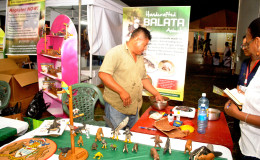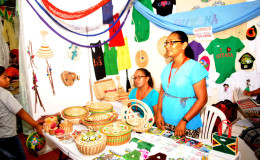It was perhaps inevitable that comparisons would be made between what was officially billed as a one-off event, last weekend’s three-day Business Exposition and annual GuyExpo that was postponed, officials said, so that government of Guyana could throw its full weight behind using GuyExpo 2016 as one of the blue-ribbon events to mark the 50th year of Guyana’s attainment of independence.

Arguably the real significance of the November 27-29 Business Exposition was that it represented the first real test of the organizational skills of the newly created Ministry of Business. In the end, the ministry passed the part of the test that had to do with creating a convivial environment for the vendors to display their goods. There was also more than ample evidence of the sense of order which Minister of Business Dominic Gaskin had wished for. That was partly due to the fact that the traditional deafening music that had become a trademark of GuyExpo had been replaced by the sober offering of steel pan.
It would have required much more, however, to have earned the event the public’s resounding accolade that it sought. People were always likely to make comparisons between the numbers GuyExpo has customarily attracted and those that its temporary replacement could trot out. And the numbers simply weren’t there to allow for a realistic comparison. The crush and confusion that have characterized GuyExpo were absent over last weekend, because the numbers were far fewer.
What GuyExpo has offered over the years is a large, one-off market; the sort of event that small vendors in the art and craft, agro-processing and beauty and fashion sectors wish for. That is why more than 250 vendors turned up at Sophia. However, most of those with whom this newspaper spoke were thankful rather than overwhelmed.

Janette Patterson owns Janet Amerindian Handicraft & Art Products at Santa Mission. She told Stabroek Business that insofar as sales were concerned there was simply no comparison between last weekend’s Business Exposition and the much more lucrative GuyExpo. For her, however, the value of this year’s event reposed in the opportunity it provided to engage new potential customers.
More fundamentally, Patterson is concerned that there is no significant local market for Amerindian craft. Growing the market, she believes, will depend on promoting the country’s tourism potential far more aggressively. Harvesting Tibisiri, an essential raw material for the Amerindian craft industry, is also a challenge. The sustained felling of trees by operators in the timber industry has meant that Tibisiri gatherers are required to travel further distances to acquire the commodity. Patterson says too that it is only at high-profile events that she can secure reasonable prices for her products.
Chris Clarke persists with what she says is a less than enterprising business. Christine’s Creative Craft specializes in dolls made of banana leaves and tie-dye fabric. She admitted that she had gone to the Business Expedition out of hope rather than expectation. When Stabroek Business spoke with her she appeared buoyant, though, up to early Sunday afternoon, she had not made a single sale.
It was the same with the other vendors. They had gone to the Business Exposition not really knowing what to expect so that the modest turnout and the fewer than expected sales did not appear to disappoint them, at least not overwhelmingly so.
Clive Rodway owns Zaf Manufacturing Company and had traveled from Number 71 Village, Corentyne to test the market for his curry powder and jerk seasoning. Over the first two days of the event he had sold 300 one-pound packets of curry powder and perhaps the same quantity of jerk seasoning. That was what all he had taken to the Expo, so that he could not have been disappointed at the outcome. He said the event had enabled him to secure a level of public awareness of his product that went way beyond the modest Corentyne market. That, for him, was a major marketing accomplishment.
Vashti Harlequin had not previously exhibited at Sophia. She had, however, taken her crocheted clothing to events in North America and the Caribbean. The Business Exposition was to be a first time test on the local market. Some of her evening dresses are priced at around $45,000 and their newness to the market meant that potential customers were content to contemplate them as a possible option rather than to make purchases. Guyana, she says, is “a difficult market.” She is prepared to use events like the Business Exposition to allow her creations to grow on local woman.
There was, perhaps, for too little evidence of an Amerindian presence at Sophia last weekend. The event, after all, would have been intended, in large measure, to bring their creations from the remote regions to the coastal market. This newspaper counted about a dozen stalls, all of them offering craft. There was a sameness about what was on offer and the lack of sales raises once again the viability of the market. The is a modest spike in sales in September, Indigenous Heritage Month, but on the whole there appears to be a greater market preference for the cheap Chinese ornaments.
Lavern Edmondson, an Amerindian craftswoman from Santa Mission who resides at Timehri does a modest wholesale business with vendors outside the Guyana Post Office on Robb Street. She appeared to understand that the opportunity afforded by the Business Exposition had to do more with “working the market” than with “getting sales.” Still, she told Stabroek Business, the Sophia event would allow her to raise her asking prices above those that she got from the pavement vendors.
It was, it seems, a better outing for the vendors offering processed food products than for the others. These days, there are higher standards of bottling, packaging and labelling. Imported condiments still appear to hold the edge on the local market, but consumers now appear more prepared to patronise the local manufacturers.
By Sunday evening, the final day of the event, the agro processors were reporting that at least 50 per cent of the goods that they had taken to Sophia had been sold. None of the other vendors could come even close to matching that claim.
To its considerable credit, Sterling Products Ltd supported 11 of the agro processors by providing packaging for their products and financing their display boards. The company also provided accommodation for the vendors residing outside of Georgetown. In a sense, Sterling Products can take a considerable measure of credit for the success realized by the agro processors at Sophia.
Amongst the vendors with whom the Stabroek Business spoke there appeared to be a consensus that the event may have been under-advertised. There appeared to be a clamour for more events of the kind though the vendors favour keeping GuyExpo. For all the distraction afforded by the loud music and the entertainment, GuyExpo, they say, serves a purpose which the Business Exposition cannot replicate. That is not to say that they are dismissing the value of the event. “Let’s see what happens next year,” was one vendor’s parting remark.




